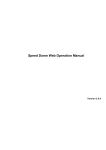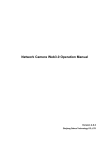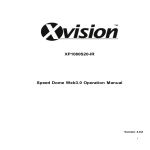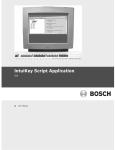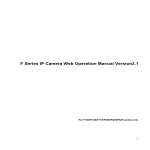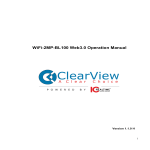Download WEB Interface V3 - HomeSystems Legrand
Transcript
User Manual LE05422AA -01CB-12W40 WEB Interface V3 EN Index 1 Network Connection.......................................................................................................................................................................................................4 2 Main Interface Introduction.........................................................................................................................................................................................4 2.1 Log in with IE...........................................................................................................................................................................................................4 2.2 Live Interface...........................................................................................................................................................................................................6 2.3 Encode Setup bar.................................................................................................................................................................................................6 2.4 System Menu ..........................................................................................................................................................................................................7 2.5 Video Window Function Option.....................................................................................................................................................................7 2.6 Video Window Setup...........................................................................................................................................................................................8 3 PTZ Control ........................................................................................................................................................................................................................9 4 Setup ................................................................................................................................................................................................................................... 11 4.1 Camera.................................................................................................................................................................................................................... 11 4.1.1 Properties ......................................................................................................................................................................................................... 11 4.1.2 Video ................................................................................................................................................................................................................... 13 4.1.3 Audio ................................................................................................................................................................................................................... 17 4.2 Network ................................................................................................................................................................................................................... 18 4.2.1 TCP/IP................................................................................................................................................................................................................ 18 4.2.2 Connection....................................................................................................................................................................................................... 20 4.2.3 PPPoE................................................................................................................................................................................................................ 21 4.2.4 DDNS.................................................................................................................................................................................................................. 21 4.2.5 IP filter ................................................................................................................................................................................................................ 22 4.2.6 SMTP (e-mail).......................................................................................................................................................................................... 23 4.2.7 UPnP................................................................................................................................................................................................................... 24 4.2.8 SNMP.................................................................................................................................................................................................................. 25 4.2.9 Bonjour............................................................................................................................................................................................................... 26 4.2.10 Multicast ............................................................................................................................................................................................................ 26 4.2.11 WiFi...................................................................................................................................................................................................................... 27 4.2.12 Qos....................................................................................................................................................................................................................... 28 4.3 4.3.1 Video detect .................................................................................................................................................................................................... 29 4.3.2 Alarm................................................................................................................................................................................................................... 33 4.3.3 Abnormity.......................................................................................................................................................................................................... 35 4.4 Storage.................................................................................................................................................................................................................... 37 4.4.1 Record schedule and snapshot schedule ....................................................................................................................................... 37 4.4.2 Destination ....................................................................................................................................................................................................... 37 4.4.3 Record control................................................................................................................................................................................................ 39 4.5 2 Event......................................................................................................................................................................................................................... 29 System..................................................................................................................................................................................................................... 40 4.5.1 General .............................................................................................................................................................................................................. 40 4.5.2 Account .............................................................................................................................................................................................................. 41 4.5.3 PTZ ...................................................................................................................................................................................................................... 44 4.5.4 Default ................................................................................................................................................................................................................ 45 4.5.5 Import/Export .................................................................................................................................................................................................. 45 4.5.6 Auto maintenance ........................................................................................................................................................................................ 46 4.5.7 Firmware update........................................................................................................................................................................................... 46 4.6 User Manual WEB Interface V3 Information............................................................................................................................................................................................................. 46 4.6.1 Version ............................................................................................................................................................................................................... 46 4.6.2 Log........................................................................................................................................................................................................................ 47 5 Alarm ................................................................................................................................................................................................................................... 48 6 Log out................................................................................................................................................................................................................................ 49 3 1 Network Connection Web service includes several modules ie monitor channel preview, PTZ control, system configuration, alarm and etc. Please check the points listed below to check network connection: 1. Make sure the IP camera has connected to the network properly. 2. Device IP address and PC IP address shall be in the same network segment. If there is router, please set the corresponding gateway and subnet mask. 3. Use order ping ***.***.***.*** (* IP camera address) to check connection is OK or not. 4. Make sure your IP Camera is in the latest software version. 2 Main Interface Introduction 2.1 Log in with IE Open IE and input IP device address in the address bar. For example, if your camera IP is 192.168.1.108, input http:// 192.168.1.108 in the IE address bar. Input the device IP address here The login interface is shown as below. Input your user name and password: default username is “admin” and default password is “admin”. Note: For security reasons, please modify your password after you first login. If it is your first time to login in, system pops up warning information to ask you whether install control webrec.cab or not. Please click OK button, system can automatically install the control. When system is upgrading, it can overwrite the previous Web too. If you can’t download the ActiveX file, please check whether you have installed the plug-in to disable the control download. Or you can lower the IE security level and disable anti-phishing filter. 4 User Manual WEB Interface V3 5 2.2 Live Interface After you logged in, you can see the live monitor window. There are four sections: Section 1: Encode Setup bar Section 2: System Menu Section 3: Window Function Option bar Section 4: Window adjust bar 2.3 Encode Setup bar The encode setup interface: Parameter Function Main stream In normal network width environment, main stream can record audio/video file and realize network monitor. You can set the main stream resolution if your device supports. Sub (Extra) stream If network width is not sufficient, you can use sub stream to realize network monitor. Protocol You can select stream media protocol from the dropdown list. There are three options:: TCP/UDP/Multicast. 6 WEB Interface V3 System Menu User Manual 2.4 Refer to chapter the following chapters for detailed informations: 2.5 - 2.2 Live - 3 PTZ - 4 Setup - 5 Alarm, - 6 Log out Video Window Function Option SN Parameter Function 1 Alarm output Click it to generate an alarm output. 2 Digital zoom Click this button and then left drag the mouse in the zone to zoom in. Right click restores original status. 3 Snapshot Snapshot important video. All images are memorized in system folder “C:\PictureDownload” (default). Go to “Setup->Camera->Video->Path” to modify the local record save path. 4 Record Click local record button, the system begins recording. The recorded file is saved to system folder: “C:\RecordDownload\”(default). Go to “Setup->Camera->Video->Path” to modify the local record save path. 5 Audio output Turn on or off audio when you are monitoring. Some products do not support this function. 6 Bidirectional talk Click it to begin audio talk. You can go to “Setup->Camera->Audio” to set bidirectional talk mode. Some products do not support this function. 7 2.6 Video Window Setup SN Parameter Function 1 Image control Click it to open picture setup interface. This interface is on the top right panel. 2 Click this button to go to original size. Original size It is to display the actual size of the video stream. It depends on the resolution set for the stream. 3 Full screen Click it to go to full-screen mode. Double click or click the Esc button to exit the full screen. 4 Width and height ratio Click it to restore original ratio or suitable window. The Image control opens the picture setup interface: Parameter Function Adjust monitor video brightness. Video setup Adjust monitor video contrast. Adjust monitor video saturation. Adjust monitor video hue. Reset 8 Restore brightness, contrast, saturation and hue to system default setup. Notes: All the operations here apply to WEB end only. Go to “Setup->Camera->Properties” to adjust corresponding items inside the camera. WEB Interface V3 User Manual 3 PTZ Control Note: Some products do not support this function. Before PTZ operation, please make sure you have properly set PTZ protocol. (Go to “Setup->System->PTZ” to set.). Here you can view direction keys, speed, zoom, focus, iris, preset, tour, pan, scan, pattern, aux close, and PTZ setup button. See below. PTZ direction: PTZ supports eight directions: left/right/up/down/upper left/upper right/bottom left/bottom right. Speed: The step 8 speed is faster than step 1. You can click this icon to display or hide the PTZ control platform Click “PTZ setup” button to open the PTZ settings interface: Parameter Scan Function Move the camera to the desired location, then click left limit button. Move the camera again then click right limit button to set a right limit. 9 Parameter Preset Function Use direction keys to move the camera to the desired location then input preset value. Click add button, the preset is set. The preset value ranges from 1 to 80. (It may vary due to different protocols.) Tour Input auto tour value and preset value. Click add button, the preset is added in the tour. Repeat the above procedures to add more presets in the tour. Or click delete button to remove one preset from the tour. The tour value ranges from 1 to 255. (It may vary due to different protocols.) Pattern Input pattern value, click start record button to begin PTZ movement. Implement camera operation with PTZ control. Then click stop record button in the “PTZ setting” interface. Assistant The assistant items include: BLC, Digital zoom, night vision, camera brightness, flip. Select one option then click start or stop button. 10 Matrix Please select the matrix then input the corresponding monitor output number, video input channel number, and then you can click video switch button to complete the operation. Light and wiper Enable or disable the light/wiper. WEB Interface V3 4.1 User Manual 4 Setup Camera 4.1.1 Properties Device property information are displayed here. Slight differences may be found due to different devices series. The setups become valid immediately after settings. Parameter Brightness Function Adjust monitor window bright. The value ranges from 0 to 100. The default value is 50. The bigger the number is, the brightest the video is. When the value is input here, the bright section and the dark section of the video will be adjusted accordingly. Use this function when the whole video is too dark or too bright. Note: the video may become hazy if the value is too high. The recommended value ranges from 40 to 60. Contrast Adjust monitor window contrast. The value ranges from 0 to 100. The default value is 50. The bigger the number is, the higher the contrast is. Use this function when the whole video brightness is OK but the contrast is not proper. Note: the video may become hazy if the value is too low. If this value is too high, the dark section may lack brightness while the bright section may over exposure .The recommended value ranges from 40 to 60. Hue Adjust monitor window hue. The value ranges from 0 to 100. The default value is 50. The input value will adjust the hue but has no effect on the general brightness of the whole video. There is a default value according to the sensitization of the sensor. Usually you do not need to do some major setup. The recommended value ranges from 40 to 60. Saturation Adjust monitor window saturation. The value ranges from 0 to 100. The default value is 50. The bigger the number is, the stronger the color is. This value has no effect on the general brightness of the whole video. The video color may become too strong if the value is too high. For the grey part of the video, the distortion may occur if the white balance is not accurate. Note: the video may not be attractive if the value is too low. The recommended value ranges from 40 to 60. Gain Mode There are two options:: manual/auto. 11 Parameter Function Gain Adjust The gain adjust is to set the gain value. The default value may vary due to different device models. The smaller the valueis , the lower the noise is. If the brightness is too low in dark environments, it can enhance the video brightness if the value is high. Exposure Mode There are two modes: Auto exposure (AE) and Manual exposure (ME). There are several values for the manual exposure mode Auto Iris Before setup, make sure you have auto iris lens is installed. Check the box ON to enable this function. The auto iris may change if the light becomes different. When this function is disabled, the iris is at the max. System does not add the auto iris function in the exposure control. This function is on by default. Some series product do not support this function. Scene Mode Set the white balance mode. It has effect on the general hue of the video. This function is auto by default. Different scene modes are selectable such as auto, sunny, cloudy, home, office, night, disable, etc in order to adjust the video to the best quality. Disabled: The white balance function is off. The video will be output at the original color. Auto: The auto white balance is on. System can auto compensate the color temperature to make sure the vide color is proper. Sunny: The threshold of the white balance is in the sunny mode. Night: The threshold of the white balance is in the night mode. Customized: You can set the gain of the red/blue channel. The value reneges from 0 to 100. Day/Night Mode Set device color and the B/W mode switch. The default setup is auto Color: Device outputs the color video. Auto: Device auto select to output the color or the B/W video according to the device feature. B/W: The device outputs the black and white video. Switch by periods: You can see the day/night mode switch time. For example, you can set the sunrise time as 06:00:00 and the sunset time as 18:00:00. The video in the specified period will be color, while the video in the rest period will be black and white. BLC This function can make the target clearer. It can make the details of the dark section become clear when the background is too bright. This function is disabled by default. Flip It is to switch video up and bottom limit. This function is disabled by default. Mirror It is to switch video left and right limit. This function is disabled by default. Some series product do not support this function. 12 WEB Interface V3 Video User Manual 4.1.2 Video streams Parameter Main stream Function Bit stream type It includes general stream, motion stream and alarm stream. You can select different encode frame rates form different recorded events. System supports active control frame function (ACF). It allows you to record in different frame rates. For example, you can use high frame rate to record important events, record scheduled event in lower frame rate and it allows you to set different frame rates for motion detection record and alarm record. Encode mode There are three options: H.264, H.264B and MJPG . The H.264 and H.264B both are H264 bit stream. H.264 is the Main Profile encode and the H.264B is the Baseline Profile encode mode. H.264B is for Blackberry cell phone to realize the monitor. MJPEG: In this encode mode, the video needs to large bit stream to guarantee the video definition. You can use the max bit stream value in the recommend bit to get the better video output effect. Resolution There are multiple resolutions. You can select from the dropdown list. Frame Rate PAL: 1~25f/s,NTSC: 1~30f/s.. Bit Rate Type There are two options: VBR and CBR. Please note, you can set video quality in VBR mode. Reference Bit Rate Reference bit rate value according to the resolution and frame rate you have set. 13 Parameter Function Bit Rate In CBR, the bit rate here is the max value. In dynamic video, system needs to low frame rate or video quality to guarantee the value. The value is null in VBR mode. Please refer to recommend bit rate for the detailed information. I Frame Interval This setting depends on the methods of reducing data. Only the first image (Iframe) is coded in its entirety and the following images (P-frame) are made with only the moving parts. Here you can set the P frame amount between two Iframes. The value ranges from 1 to 150. Default value is 50. Note: The smaller the value, the bigger the bandwidth need is. Watermark This function allows you to verify the video is tampered or not. Here you can select watermark bit stream, watermark mode and watermark character. Default character is “DigitalCCTV”. The max length is 85-digit. The character can only include number, character and underline. Sub stream Enable Please check the box here to enable extra stream function. This function is enabled by default. Bit stream type General bit stream. Encode mode There are three options: H.264(main profile standard, H.264B(baseline standard)encode and MJPG encode. The H.264 and H.264B both are H264 bit stream. H.264 is the Main Profile encode and the H.264B is the Baseline Profile encode mode. H.264B is for Blackberry cell phone to realize the monitor. You need to enable the sub stream function in your camera and set the resolution as CIF. Then you can monitor via the Blackberry cell phone. MJPEG: In this encode mode, the video needs to large bit stream to guarantee the video definition. You can use the max bit stream value in the recommend bit to get the better video output effect. Resolution There are multiple resolutions. You can select from the dropdown list. For each resolution, the recommended bit stream value is different. Frame Rate PAL: 1~25f/s,NTSC: 1~30f/s.. The frame rate may vary due to different resolutions. Bit Rate Type There are two options: VBR and CBR. Please note, you can set video quality in VBR mode. Recommended Bit Bit Rate Recommended bit rate value according to the resolution and frame rate you have set. In CBR, the bit rate here is the max value. In dynamic video, system needs to low frame rate or video quality to guarantee the value. The value is null in VBR mode. Please refer to recommend bit rate for the detailed information. I Frame This setting depends on the methods of reducing data. Only the first image (Iframe) is coded in its entirety and the following images (P-frame) are made with only the moving parts. Here you can set the P frame amount between two Iframes. The value ranges from 1 to 150. Default value is 50. Note: The smaller the value, the bigger the bandwidth need is. 14 WEB Interface V3 User Manual Snapshot Parameter Function Snapshot type There are two modes: General (Schedule in Storage menu) and Event (activation). Image size It is the same with the resolution of the main stream. Quality It is to set the image quality. There are six levels. Interval It is to set snapshot frequency. The value ranges from 1s to 7s. 15 Video Overlay Parameter Function Privacy mask Here you can privacy mask the specified video in the monitor video. System max supports 4 privacy mask zones. Time Title You can enable this function so that system overlays time information in video window. You can use the mouse to drag the time tile position. Channel Title You can enable this function so that system overlays channel information in video window. You can use the mouse to drag the channel tile position. Path The storage path interface is shown below. Here you can set snapshot saved path ( in the preview interface) and the record storage path ( interface).The default setup is “C:\PictureDownload” and “C:\RecordDownload”. Please click the “Save” button to save current setup. 16 in the preview WEB Interface V3 Audio User Manual 4.1.3 Please note some series product does not support this function. The audio interface is shown as below. Parameter Function Audio enable Main stream: Recorded file only contains video by default. You need to check the audio box here to enable audio function. Sub (Extra) stream: Recorded file only contains video by default. You need to check the audio box here to enable audio function. Encode mode The encode mode of the main stream and extra stream include PCM, G.711A and G.711Mu. The setup here is for audio encode mode and the bidirectional talk encode both. 17 4.2 4.2.1 Network TCP/IP Parameter Function Host Name It is to set current host device name. It max supports 32-digit character. Ethernet Card Please select the Ethernet port. It is for the wire LAN by default. Please note the device needs to reboot to activate the new setup once you modify the default setup. Mode There are two modes: “Static” mode and the “DHCP” mode. The IP/submask/gateway are null when you select the DHCP mode to auto search the IP. If you select the static mode, you need to set the IP/submask/gateway manually. If you select the DHCP mode, you can view the IP/submask/gateway from the DHCP. If you switch from the DHCP mode to the static mode, you need to reset the IP parameters. Mac Address It is to display host Mac address. IP Version It is to select IP version. IPV4 or IPV6. You can access the IP address of these two versions. 18 IP Address Please use the keyboard to input the corresponding number to modify the IP address and then set the corresponding subnet mask and the default gateway. Preferred DNS DNS IP address. Alternate DNS Alternate DNS IP address. Parameter Function Enable ARP/Ping set device IP address service. You can use ARP/Ping command to modify or set the device IP address if you know the device MAC address. User Manual WEB Interface V3 Before the operation, please make sure the IP Camera and the PC in the same LAN. This function is on by default. You can refer to the steps listed below. Step 1: Get an IP address. Set the IP Camera and the PC in the same LAN. Step 2: Get the physical address from the label of the IP Camera. Step 3: Go to the Run interface and then input the following commands. arp –s <IP Address> <MAC> ping –l 480 –t <IP Address> Such as:arp -s 192.168.0.125 11-40-8c-18-10-11 ping -l 480 -t 192.168.0.125 Step 4: Reboot the device. Step 5: You can see the setup is OK if you can see there are output information such as “Reply from 192.168.0.125 …” from the command output lines. Now you can close the command line. Step 6: Open the browse and then input http://<IP addres>. Click the Enter button, you can access now. 19 4.2.2 Connection Parameter Function Max connection It is the max Web connection for the same device. The value ranges from 1 to 20. TCP port The default value is 37777. UDP port The default value is 37778. HTTP port The default value is 80. RTSP port The default value is 554. Rtsp stream query format is: Main stream: “rtsp://username:password@ip:port/cam/realmonitor?channel=1&subtype=0” Sub stream: “rtsp://username:password@ip:port/cam/realmonitor?channel=1&subtype=1” You need to input the following four items manually. Username/password/IP and port. The IP is device IP and the port default value is 554. You can leave it in blank if it is the default value. You do not need to input the user name and password if you do not need to the verification. Such as: “rtsp://ip:port/cam/realmonitor?channel=1&subtype=0” 20 WEB Interface V3 PPPoE User Manual 4.2.3 Input the PPPoE user name and password you get from the IPS (internet service provider) and enable PPPoE function. Please save current setup and then reboot the device to get the setup activated. Device connects to the internet via PPPoE after reboot. You can get the IP address in the WAN from the IP address column. 4.2.4 DDNS The DDNS is to set to connect the various servers so that you can access the system via the server. Please go to the corresponding service website to apply a domain name and then access the system via the domain. It works even your IP address has changes. Parameter Function Server Type You can select DDNS protocol from the dropdown list and then enable DDNS function. The private DDNS protocol means you use your self-defined private protocol to realize DDNS function. Server IP DDNS server IP address Server Port DDNS server port. Domain Name Your self-defined domain name. User The user name you input to log in the server. Password The password you input to log in the server. Update period Device sends out alive signal to the server regularly. You can set interval value between the device and DDNS server here. 21 4.2.5 IP filter You can enable IP filter function so that some specified IP user can access the IP Camera. You can add IP address or IP address section. If you do not check the box here, it means there is no access limit. 22 WEB Interface V3 SMTP (e-mail) User Manual 4.2.6 Parameter Function SMTP Server Input server address and then enable this function. Port Default value is 25. You can modify it if necessary. Anonymity For the server supports the anonymity function. You can auto login anonymously. You do not need to input the user name, password and the sender information. Username The user name of the sender email account. Password The password of sender email account. Sender Sender email address. Authentication (Encryption mode) You can select SSL or none. Title (Subject) Input email subject here. Attachment System can send out the email of the snapshot picture once you check the box here. Mail Receiver Input receiver email address here max three addresses.. Interval The send interval ranges from 0 to 3600 seconds. 0 means there is no interval. Please note system will not send out the email immediately when the alarm occurs. When the alarm, motion detection or the abnormity event activates the email, system sends out the email according to the interval you specified here. This function is very useful when there are too many emails activated by the abnormity events, which may result in heavy load for the email server. Health mail enable Please check the box here to enable this function. Update period (interval) This function allows the system to send out the test email to check the connection is OK or not. Please check the box to enable this function and then set the corresponding interval. System can send out the email regularly as you set here. Email test The system will automatically sent out a email once to test the connection is OK or not .Before the email test, please save the email setup information. 23 4.2.7 UPnP It allows you to establish the mapping relationship between the LAN and the public network. Here you can also add, modify or remove UPnP item. In the Windows OS, from “Start->Control Panel->Add/remove programs”. Click the “Add/Remove Windows Components” and then select the “Network Services” from the Windows Components Wizard. Click the “Details” button and then check the “Internet Gateway Device Discovery and Control client” and “UPnP User Interface”. Please click “OK” to begin installation. Enable UPnP from the Web. If your UPnP is enabled in the Windows OS, the IP Camera can auto detect it via the “My Network Places”. In the case of a router that supports this protocol, it opens the ports forwarding automatically. 24 WEB Interface V3 SNMP User Manual 4.2.8 The SNMP allows the communication between the network management work station software and the proxy of the managed device. You need to reboot the device to activate the new setup. Parameter Function SNMP V1 System only processes the information of V1. SNMP V2 System only processes the information of V2. SNMP Port The listening port of the proxy program of the device. It is a UDP port not a TCP port. The value ranges from 1 to 65535. The default value is 161 Read Community It is a string. It is a command between the manage process and the proxy process. It defined the authentication, access control and the management relationship between one proxy and one group of the managers. Please make sure the device and the proxy are the same. The read community will read all the objects the SNMP supported in the specified name. The default setup is public. Write Community It is a string. It is a command between the manage process and the proxy process. It defined the authentication, access control and the management relationship between one proxy and one group of the managers. Please make sure the device and the proxy are the same. The read community will read/write/access all the objects the SNMP supported in the specified name. The default setup is write. Trap address The destination address of the Trap information from the proxy program of the device. Trap port The destination port of the Trap information from the proxy program of the device. It is for the gateway device and the client-end PC in the LAN to exchange the information. It is a nonprotocol connection port. It has no effect on the network applications. It is a UDP port not TCP port. The value ranges from 1 to 165535. The default value is 162. 25 4.2.9 Bonjour Bonjour is based on the multicast DNS service from the Apple. The Bonjour device can automatically broadcast its service information and listen to the service information from other device. You can use the browse of the Bonjour service in the same LAN to search the IP Camera device and then access if you do not know the IP Camera information such as IP address. You can view the server name when the IP Camera is detected by the Bonjour. Please note the safari browser support this function. Click the “Display All Bookmarks: and open the Bonjour, system can auto detect the IP Camera of the Bonjour function in the LAN. 4.2.10 Multicast When there is multiple-host to receive the same data packet, multiple-cast is the best option to reduce the broad width and the CPU load. The source host can just send out one data to transit. This function also depends on the relationship of the group member and group of the outer. Here you can set multicast address and port. You also need to go to Live interface to set the protocol as Multicast. 26 WEB Interface V3 User Manual 4.2.11 WiFi Please note this function is only for the devices with WIFI module. Please check the box to enable WIFI function and then click the Search SSID button. Now you can view all the wireless network information in the following list. Double click a name to connect to it. See the picture below. 27 4.2.12 Qos Qos (Quality of Service) is network security mechanism. It is a technology to fix the network delay and jam problem and etc. For the network service, the quality of service includes the transmission bandwidth, delay, the packet loss and etc. The transmission bandwidth, lower the delay, reduce the loss of the data packet and anti-dither can be guaranteed to enhance the quality. We can set the DSCP (Differentiated Services Code Point) of the IP to distinguish the data packet so that the router or the switch can provide different services for various data packets. It can select the different queues according to the priority of the packets and select the bandwidth of the each queue. It can also discard at the different ratio when the broad bandwidth is jam. 28 Parameter Function Real-time monitor The value ranges from 0 to 63. The router or the switcher can provide different service for various data packets. Command The value ranges from 0 to 63. The router or the switcher can provide different service for various data packets. WEB Interface V3 4.3.1 Event User Manual 4.3 Video detect Motion Detect 29 Parameter Function Enable You need to check the box to enable motion detection function. Working Period Motion detection function becomes activated in the specified periods. See picture above. There are six periods in one day. Please check the box to enable corresponding period. Select date. If you do not select, current setup applies to today only. You can select all week column to apply to the whole week. Click “Save” button, system goes back to motion detection interface; please click “Save” button to exit. Anti-dither System only memorizes one event during the anti-dither period. The value ranges from 0s to 100s. Sensitivity There are six levels. The sixth level has the highest sensitivity. Area Area: If you select motion detection type, you can click this button to set motion detection zone. The interface is shown as in the picture above. There are PAL 22X18/NTSC 22X15 zones. Click “Save” button, system goes back to motion detection interface; please click “Save” button to exit.. Record channel System auto activates motion detection channel to record once alarm occurs (working with motion detection function). Please note you need to go to “Storage-> Schedule” to set current channel as general record. Record Delay System can delay the record for specified time after alarm ended. The value ranges from 10s to 300s. Relay out Enable alarm activation function. You need to select alarm output port so that system can activate corresponding alarm device when alarm occurs. Some series product does not support this function. Alarm Delay System can delay the alarm output for specified time after alarm ended. The value ranges from 10s to 300s. Some series product does not support this function. Send Email 30 If you enabled this function, System can send out email to alert you when alarm occurs and ends. Parameter Function PTZ Here you can set PTZ movement when alarm occurs. Such as go to preset x when there is an alarm. User Manual WEB Interface V3 The event type includes: preset, tour and pattern. Some series product does not support this function. Snapshot You need to check the box here so that system can backup motion detection snapshot file. Video Masking Parameter Function Enable You need to check the box to enable this function. Working Period Video masking function becomes activated in the specified periods. There are six periods in one day. Please draw a circle to enable corresponding period. Select date. If you do not select, current setup applies to today only. You can select all week column to apply to the whole week. Click “Save” button, system goes back to Video Masking interface, please click “Save” button to exit. Record System auto activates motion detection channel to record once alarm occurs (working with motion detection function). Please note you need to go to Storage-> Schedule to set current channel as general record. Record Delay System can delay the record for specified time after alarm ended. The value ranges from 10s to 300s. Relay out Enable alarm activation function. You need to select alarm output port so that system can activate corresponding alarm device when alarm occurs. Some series product does not support this function. Alarm Delay System can delay the alarm output for specified time after alarm ended. The value ranges from 10s to 300s. Some series product does not support this function. 31 Parameter Function Send Email If you enabled this function, System can send out email to alert you when alarm occurs. PTZ Here you can set PTZ movement when alarm occurs. Such as go to preset x when there is an alarm. The event type includes: preset, tour and pattern. Some series product does not support this function. Snapshot 32 You need to input capture channel number so that system can backup motion detection snapshot file. WEB Interface V3 Alarm User Manual 4.3.2 Please note some series product does not support this function. Alarm Activation Parameter Function Enable You need to check the box to enable this function. Working Period This function becomes activated in the specified periods. There are six periods in one day. Please draw a circle to enable corresponding period. Select date. If you do not select, current setup applies to today only. You can select all week column to apply to the whole week. Click “Save” button, system goes back to Relay Activation interface, please click “Save” button to exit. Anti-dither System only memorizes one event during the anti-dither period. The value ranges from 0s to 100s. Sensor type There are two options: NO (Normal Open)/NC (Normal Close) Record System auto activates motion detection channel to record once alarm occurs (working with motion detection function). Please note you need to go to Storage-> Schedule to set current channel as general record. Record Delay System can delay the record for specified time after alarm ended. The value ranges from 10s to 300s. Relay out There is 1-channel alarm output. Corresponding to motion detection alarm output port. Enable alarm activation function. You need to select alarm output port so that system can activate corresponding alarm device when alarm occurs. Alarm Delay System can delay the alarm output for specified time after alarm ended. The value ranges from 10s to 300s. Send Email If you enabled this function, System can send out email to alert you when alarm occurs and ends. PTZ Here you can set PTZ movement when alarm occurs. Such as go to preset x when there is an alarm. The event type includes: preset, tour and pattern. 33 Parameter Function Snapshot You need to input capture channel number so that system can backup motion detection snapshot file. Relay output 34 Parameter Function Trigger There is only one output channel. Please click the button 1. If you want to enable the alarm activation output function, please press the corresponding button and then trigger. Refresh Search alarm output status. WEB Interface V3 Abnormity User Manual 4.3.3 It includes five statuses: No SD card, capacity warning, SD card error, and disconnection and IP conflict. There are two interfaces for you reference. See the pictures below. 35 Parameter Function Event Type The abnormal events include: no disk, no space, disk error, net error, offline, IP conflict. Threshold: You can set the minimum percentage value here. The device can alarm when capacity is not sufficient. You need to check the box to enable this function. Record System auto activates channel to record once alarm occurs (For offline type only. See the picture above. You need to check the box to enable this function. Record Delay System can delay the record for specified time after alarm ended. The value ranges from 10s to 300s. Relay Out The corresponding alarm output channel when alarm occurs. You need to check the box to enable this function. Some series product does not support this function. Relay out Delay The alarm output can delay for the specified time after alarm stops. The value ranges from 10s to 300s. Some series product does not support this function. Send email If you enable this function, system can send out email to alarm the specified user. This function is invalid when network is offline or IP conflict occurs. 36 WEB Interface V3 4.4.1 Storage User Manual 4.4 Record schedule and snapshot schedule In these two interfaces, you can add or remove the schedule record/snapshot setup.. There are three record modes: general (auto), motion detect and alarm. There are six periods in one day. Please make sure you have enabled the corresponding record mode in the “Setup->Storage->Conditions”. You can view the current time period setup from the color bar. Green color stands for the general record/snapshot. Yellow color stands for the motion detect record/snapshot.. Red color stands for the alarm record/snapshot. 4.4.2 Destination It is to set the storage mode of the IP Camera record file or snapshot pictures. There are three options: local/FTP/network. You can only select one mode. System can save according to the event types. It is corresponding to the three modes (general/motion/alarm) in the Schedule interface. Please check the box to enable the saved functions. Parameter Function Event Type It includes: general, motion detect and alarm. Local It saved in the SD card. FTP It saved in the FTP server. Network It can save according to the corresponding network protocol. In the local interface, you can view local SD card or disk information. You can also operate the read-only, write-only, hot swap and format operation. 37 You need to check the box to enable the FTP function. When network disconnect occurred or there is malfunction. Emergency storage can save the record/snapshot picture to the local SD card. 38 WEB Interface V3 Record control User Manual 4.4.3 Parameter Function Pack Duration Here you can select file size. Default setup is 8 minutes. Pre-record Please input pre-record value here. For example, system can record the four seconds video in the buffer. The record begins from the fifth second. Disk Full There are two options: stop recording or overwrite the previous files when HDD is full. Stop: Current working HDD is overwriting or current HDD is full, it will stop record. Overwrite: Current working HDD is full; it will overwrite the previous file. Record mode There are three modes: Auto/manual/close. 39 4.5 4.5.1 System General The general interface includes the local host setup and the date/time setup. Local host. Parameter Function Device Name It is to set device name. Language You can select the language from the dropdown list. Please note the device needs to reboot to get the modification activated. Video Standard This is to display video standard such as PAL. Date and time 40 Parameter Function Date format Here you can select date format from the dropdown list. Time Format There are two options: 24-H and 12-H. Time zone The time zone of the device. System time It is to set system time. It becomes valid after you set. 4.5.2 Sync PC You can click this button to save the system time as your PC current time. DST Here you can set day night save time begin time and end time. You can set according to the date format or according to the week format. NTP You can check the box to enable NTP function. NTP server You can set the time server address. Port It is to set the time server port. Update period It is to set the sync periods between the device and the time server. User Manual WEB Interface V3 Account Note: For the character in the following user name or the user group name, system max supports 6-digits. The space in the front or at the end of the string is null. The valid string includes: character, number, and underline. The user amount is 20 and the group amount is 8 when the device is shipped out of the factory. The factory default setup includes two levels: user and admin. You can set the corresponding group and then set the rights for the respective user in the specified groups. User management adopts group/user modes. The user name and the group name shall be unique. One user shall be included in only one group. User name Add user: It is to add a name to group and set the user rights. There are four default users: admin/888888/666666 and hidden user “default”. Except user 6666, other users have administrator right. The user 666666 can only have the monitor rights,. Hidden user “default” is for system interior use only and cannot be deleted. When there is no login user, hidden user “default” automatically login. You can set some rights such as monitor for this user so that you can view some channel view without login. Here you can input the user name and password and then select one group for current user. Please note the user rights shall not exceed the group right setup. For convenient setup, please make sure the general user has the lower rights setup than the admin. 41 Modify user It is to modify the user property, belonging group, password and rights. Modify password It is to modify the user password. You need to input the old password and then input the new password twice to confirm the new setup. Please click the OK button to save. Please note, the password ranges from 1-digit to 6-digit. It shall include the number only. For the user of the account rights, he can modify the password of other users. Group The group management interface can add/remove group, modify group password and etc. 42 User Manual WEB Interface V3 Add group: It is to add group and set its corresponding rights. Please input the group name and then check the box to select the corresponding rights. It includes: shutdown/reboot device, live view, record control, PTZ control and etc. Modify group Here you can modify group information such as remarks and rights. 43 4.5.3 PTZ Please note some series product does not support this function. 44 Parameter Function Protocol Select the corresponding dome protocol. Address Set corresponding dome address. Default value is 1. Please note your setup here shall comply with your dome address; otherwise you can not control the speed dome. Baud Rate Select the dome baud rate. Default setup is 9600. Data Bit Default setup is 8. Please set according to the speed dome dial switch setup. Stop bit Default setup is 1. Please set according to the speed dome dial switch setup. Parity Default setup is none. Please set according to the speed dome dial switch setup. WEB Interface V3 Default User Manual 4.5.4 Please note system cannot restore some information such as network IP address. 4.5.5 Import/Export Parameter Function Import It is to import the local setup files to the system. Export It is to export the corresponding system setup to your local PC. 45 4.5.6 Auto maintenance Here you can select auto reboot and auto delete old files interval from the dropdown list. If you want to use the auto delete old files function, you need to set the file period. 4.5.7 Firmware update Please select the upgrade file and then click the update button to begin firmware update. Important Improper upgrade program may result in device malfunction! 4.6 4.6.1 Information Version Here you can view system hardware features, software version, release date and etc. Please note the following information is for reference only. 46 WEB Interface V3 Log User Manual 4.6.2 Parameter Function Type Log types include: system operation, configuration operation, data operation, event operation, record operation, user management, log clear. Start time Set the start time of the requested log. End time Set the end time of the requested log. Search You can select log type from the drop down list and then click search button to view the list. You can click the stop button to terminate current search operation. Detailed information You can select one item to view the detailed information. Clear You can click this button to delete all displayed log files. Please note system does not support clear by type. Backup You can click this button to backup log files to current PC. 47 5 Alarm Here you can set device alarm type and alarm sound setup. Type Parameter Function Alarm type Motion detection System alarms when motion detection alarm occurs, Disk full System alarms when disk is full. HDD malfunction System generates an alarm when HDD is malfunction. Camera masking System alarms when camera is viciously masking. External alarm Alarm input device sends out alarm. Some series product does not support this function. 48 Operation Prompt System automatically pops up alarm dialogue box. Alarm audio Audio When alarm occurs, system auto generates alarm audio. The audio supports customized setup. Path Here you can specify alarm sound file. WEB Interface V3 User Manual 6 Log out 49




















































